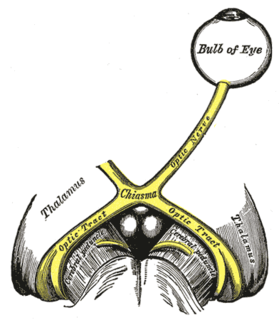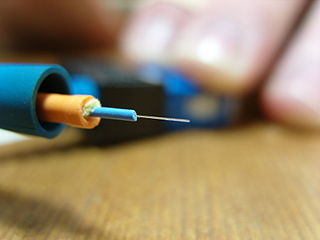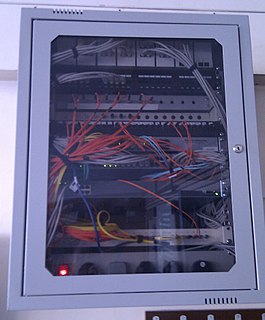
Fiber Distributed Data Interface (FDDI) is a standard for data transmission in a local area network. It uses optical fiber as its standard underlying physical medium, although it was also later specified to use copper cable, in which case it may be called CDDI, standardized as TP-PMD, also referred to as TP-DDI.

A metropolitan area network (MAN) is a computer network that interconnects users with computer resources in a geographic metropolitan area or region. The term MAN is applied to the interconnection of local area networks (LANs) in a city into a single larger network which may then also offer efficient connection to a wide area network. The term is also used to describe the interconnection of several local area networks in a metropolitan area through the use of point-to-point connections between them.

In computer networking, Gigabit Ethernet is the various technologies for transmitting Ethernet frames at a rate of a gigabit per second, as defined by the IEEE 802.3-2008 standard. It came into use beginning in 1999, gradually supplanting Fast Ethernet in wired local networks, as a result of being considerably faster. The cables and equipment are very similar to previous standards and have been very common and economical since 2010.

The optic nerve, also known as cranial nerve II, or simply as CN II, is a paired nerve that transmits visual information from the retina to the brain. In humans, the optic nerve is derived from optic stalks during the seventh week of development and is composed of retinal ganglion cell axons and glial cells; it extends from the optic disc to the optic chiasma and continues as the optic tract to the lateral geniculate nucleus, pretectal nuclei, and superior colliculus.
XENPAK is a multisource agreement (MSA), instigated by Agilent Technologies and Agere Systems, that defines a fiber-optic or wired transceiver module which conforms to the 10 Gigabit Ethernet (10GbE) standard of the Institute of Electrical and Electronics Engineers (IEEE) 802.3 working group. The MSA group received input from both transceiver and equipment manufacturers during the definition process. XENPAK has been replaced by more compact devices providing the same functionality.
The V band ("vee-band") is a standard designation by the Institute of Electrical and Electronic Engineers (IEEE) for a band of frequencies in the microwave portion of the electromagnetic spectrum ranging from 40 to 75 gigahertz (GHz). The V band is not heavily used, except for millimeter wave radar research and other kinds of scientific research. It should not be confused with the 600–1000 MHz range of Band V of the UHF frequency range.
A passive optical network (PON) is a telecommunications technology used to provide fiber to the end consumer, both domestic and commercial. A PON's distinguishing feature is that it implements a point-to-multipoint architecture, in which unpowered fiber optic splitters are used to enable a single optical fiber to serve multiple end-points. The end-points are often individual customers, rather than commercial. A PON does not have to provision individual fibers between the hub and customer. Passive optical networks are often referred to as the "last mile" between an ISP and customer.
LattisNet was a family of computer networking hardware and software products built and sold by SynOptics Communications during the 1980s. Examples were the 1000, 2500 and 3000 series of LattisHub network hubs. LattisNet was the first implementation of 10 Megabits per second local area networking over unshielded twisted pair wiring in a star topology.

Multi-mode optical fiber is a type of optical fiber mostly used for communication over short distances, such as within a building or on a campus. Typical multi-mode links have data rates of 10 Mbit/s to 10 Gbit/s over link lengths of up to 600 meters. Multi-mode fiber has a fairly large core diameter that enables multiple light modes to be propagated and limits the maximum length of a transmission link because of modal dispersion.
Plastic optical fiber (POF) is an optical fiber that is made out of polymer. Similar to glass optical fiber, POF transmits light through the core of the fiber. Its chief advantage over the glass product, other aspect being equal, is its robustness under bending and stretching. Optical fiber used in telecommunications is governed by European Standards EN 60793-2-40-2011.

An optical fiber is a flexible, transparent fiber made by drawing glass (silica) or plastic to a diameter slightly thicker than that of a human hair. Optical fibers are used most often as a means to transmit light between the two ends of the fiber and find wide usage in fiber-optic communications, where they permit transmission over longer distances and at higher bandwidths than electrical cables. Fibers are used instead of metal wires because signals travel along them with less loss; in addition, fibers are immune to electromagnetic interference, a problem from which metal wires suffer excessively. Fibers are also used for illumination and imaging, and are often wrapped in bundles so they may be used to carry light into, or images out of confined spaces, as in the case of a fiberscope. Specially designed fibers are also used for a variety of other applications, some of them being fiber optic sensors and fiber lasers.

IEEE Standard 1355-1995, IEC 14575, or ISO 14575 is a data communications standard for Heterogeneous Interconnect (HIC).

Fiber to the x (FTTX) or fiber in the loop is a generic term for any broadband network architecture using optical fiber to provide all or part of the local loop used for last mile telecommunications. As fiber optic cables are able to carry much more data than copper cables, especially over long distances, copper telephone networks built in the 20th century are being replaced by fiber.

The Ethernet physical layer is the physical layer functionality of the Ethernet family of computer network standards. The physical layer defines the electrical or optical properties of the physical connection between a device and the network or between network devices. It is complemented by the MAC layer and the logical link layer.
Ethernet in the first mile (EFM) refers to using one of the Ethernet family of computer network protocols between a telecommunications company and a customer's premises. From the customer's point of view it is their "first" mile, although from the access network's point of view it is known as the "last mile". A working group of the Institute of Electrical and Electronics Engineers (IEEE) produced the standards known as IEEE 802.3ah-2004, which were later included in the overall standard IEEE 802.3-2008. Although it is often used for businesses, it can also be known as Ethernet to the Home (ETTH). One family of standards known as EPON uses a passive optical network.

Fiber-optic communication is a method of transmitting information from one place to another by sending pulses of light through an optical fiber. The light forms an electromagnetic carrier wave that is modulated to carry information. Fiber is preferred over electrical cabling when high bandwidth, long distance, or immunity to electromagnetic interference are required.
40 Gigabit Ethernet (40GbE) and 100 Gigabit Ethernet (100GbE) are groups of computer networking technologies for transmitting Ethernet frames at rates of 40 and 100 gigabits per second (Gbit/s), respectively. The technology was first defined by the IEEE 802.3ba-2010 standard and later by the 802.3bg-2011, 802.3bj-2014, and 802.3bm-2015 standards.

10 Gigabit Ethernet is a group of computer networking technologies for transmitting Ethernet frames at a rate of 10 gigabits per second. It was first defined by the IEEE 802.3ae-2002 standard. Unlike previous Ethernet standards, 10 Gigabit Ethernet defines only full-duplex point-to-point links which are generally connected by network switches; shared-medium CSMA/CD operation has not been carried over from the previous generations Ethernet standards so half-duplex operation and repeater hubs do not exist in 10GbE.
Centro Studi e Laboratori Telecomunicazioni (CSELT) was an Italian research center for Telecommunication based in Torino, the biggest in Italy and one of the most important in Europe. It played a big role internationally especially in the standardization of protocols and technologies in telecommunication: perhaps the most widely well known is the standardization of mp3. It was active from 1964 to 2001, initially as a part of the Istituto per la Ricostruzione Industriale-STET – Società Finanziaria Telefonica group, the major conglomerate of Italian public Industries in the 1960s and 1970s; it later became part of Telecom Italia Group. In 2001 was renamed TILAB as part of Telecom Italia Group.
Classic Ethernet is a generic term for the family of 10 Mbit/s Ethernet standards, which is the first generation of Ethernet standards. In 10BASE-X, the 10 represents its maximum throughput of 10 Mbit/s, BASE indicates its use of baseband transmission, and X indicates the type of medium used.












